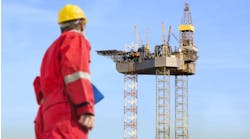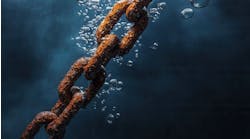Early sand detection can prolong life of equipment, increase production
Acoustic system may offer solution
William Furlow
Editor-in-Chief
One of the problems with the highly productive fields off the East Coast of Trinidad is that they are producing from very young sands. The production on BP Trinidad and Tobago's flagship Mahogany field, for example, comes from a formation that is only 1.8 million years old. Due to the age and other factors, these are mostly unconsolidated formations with little or no natural cementing. This, combined with the high flow rates typical in modern offshore wells, leads to increased sand production.
Erosion
Sand is bad news for wells and the equipment installed on them. Running quickly through flowlines, chokes, and topside equipment, these particles can rapidly erode the inside of equipment. Sand can also clog production equipment, causing wells to be prematurely shut in or even abandoned. One key to overcoming the sand problem is to determine when it occurs before it does any damage.
For years data and field experience have been gathered on a number of fields offshore Trinidad, with an eye toward developing an acoustic sand detection system.
The system itself is basically a listening device.
"It monitors any noise through the flowline at any time," said Ian Allahar of BPTT. Allahar made a presentation on the device at the recent Latin America, Caribbean Petroleum Engineer-ing Conference in Trinidad. The device can be strapped onto a flowline at the topsides, or below the waterline. Once in place, the non-intrusive device listens for changes in the amount of noise caused by production flowing from the well. Once a baseline is established, a component of any increase in noise could indicate sand rattling through the line.
The amount of baseline noise produced by flow varies according to the properties of the fluid phase, the amount of gas in the flow mix, and the velocity of the flow. The acoustic detector must be optimally installed to provide the lowest possible sand detection level. Typically, the optimum location is downstream of an elbow, as these areas are most susceptible to erosion damage due to sand impingement on the pipe wall.
Once the best installation point is identified and the device is installed, a known quantity of sand is introduced into the flow. This sand is determined to be of the same size as the sand the well would be producing, based on core data and experience from nearby wells. By reading the change in the noise signal as the sand passes by the detection system, the engineers can calibrate the device and set alarm limits for the operator. Once in place, the device will alert an operator if sand production increases beyond preset limits. Changes in the flow can be made quickly to avoid undue damage to the production equipment.
Mixing it up
Such a system has been used on over 30 wells in Trinidad, and the data retrieved from these applications is now part of an effort to predict how the sand production will vary given different flow characteristics. This limitation is a major shortcoming of such systems. While the system works to detect changes in the noise coming off the flowline, it must be properly calibrated to ensure these changes properly reflect the level of sand production.
Currently, every time even a minor change is made in a choke setting, reservoir pressure drops, or there is a variation in the composition of the production, the detector must be recalibrated. That requires a trip offshore, adding expense and inconvenience. The goal of this current study is to eliminate the need for recalibration by factoring in how the signal will change under a variety of different flow conditions.
The study showed a number of interesting results. For example, the greater the gas component in a flow profile, the noisier it becomes. Likewise, a large liquid fraction in the flow composition reduces the noise by a given quantity of sand production.
It is critical to distinguish when a signal is affected by the flow composition. In cases of high water cut, the additional liquids may dampen the signal. Increased sand production is often associated with increased water production. If the water masks the increase in sand production, then the detection system would fail to alert the operator of the change. Without proper prediction tools, the operator may receive results that show sand production is within limits.
"You are given a false sense of security," said Allahar.
Allahar is developing a model that will account for changes in flow rate, composition, and volume. To aid him in this work, he has gathered data from BP's Amherstia, Immortelle, and Mahogany fields.
Though this model is still under development, it has been determined that the sand concentration is related to the velocity of the flow as well as the gas/liquid mixture. If the operator knows the size of the sand particles and the velocity of the mixture, then it is possible to predict how much sand is being produced, once the system is initially calibrated.
Once the model is tested and its reliability confirmed, it would not only improve the life of production equipment and wells offshore, but also reduce the cost of maintaining such a system by automating virtually all aspects of detecting sand production.


